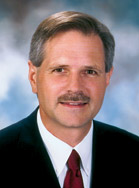 It is easy being green this year at the 2008 North American International Auto Show (NAIAS) in Detroit.
It is easy being green this year at the 2008 North American International Auto Show (NAIAS) in Detroit.
Reece Nanfito, Marketing Director for the Ethanol Promotion and Information Council, is there and he reports that “the whole place is buzzing about alternative fuels.”
Ferrari is showing a Biofuel Ferrari for North America that is all about being green. The Associated Press picked up on the story that Ferrari is experimenting with ethanol to help its luxury sports cars produce lower emissions and improve fuel economy.
Ferrari said Monday it developed an engine for an F430 Spider to run on E85, an 85% ethanol blend. The automaker said it produces 5 percent less carbon dioxide emissions and boosts horsepower by 10 percent.
 Nanfito was especially impressed with the Mazda Furai, which he says is an amazingly futuristic car. “Apparently E98 is the fuel of the future, because that is how they designed the car,” said Nanfito. “Our logo is on it, along with BP, and it is getting a lot of attention.”
Nanfito was especially impressed with the Mazda Furai, which he says is an amazingly futuristic car. “Apparently E98 is the fuel of the future, because that is how they designed the car,” said Nanfito. “Our logo is on it, along with BP, and it is getting a lot of attention.”
CNN Money headlined the “E100 Powered Furai Concept” reporting that “the Furai looks as if it’s straight off the race track and features an “air fin” on top to help keep the engine cool.”
Check out the NAIAS show cam for more photos.


 E85, a blend of 85 percent ethanol and 15 percent gasoline, will make its appearance in 2008 as a fuel alternative in the American Le Mans Series.
E85, a blend of 85 percent ethanol and 15 percent gasoline, will make its appearance in 2008 as a fuel alternative in the American Le Mans Series. According to the
According to the  “By showcasing the capabilities of E85 ethanol before an audience of knowledgeable and technically astute race fans, we can demonstrate the benefits of a renewable fuel that helps to reduce dependence on petroleum, helps to reduce emissions of greenhouse gases, and helps to create greater diversity in energy supplies,” Chevrolet General Manager Ed Peper said. “Of course, performance is what counts in racing, so E85 ethanol’s higher octane rating than gasoline wasn’t overlooked by the Corvette Racing engineers.”
“By showcasing the capabilities of E85 ethanol before an audience of knowledgeable and technically astute race fans, we can demonstrate the benefits of a renewable fuel that helps to reduce dependence on petroleum, helps to reduce emissions of greenhouse gases, and helps to create greater diversity in energy supplies,” Chevrolet General Manager Ed Peper said. “Of course, performance is what counts in racing, so E85 ethanol’s higher octane rating than gasoline wasn’t overlooked by the Corvette Racing engineers.”
 “It’s a little bit of a surprise to see how much the market has rebounded,” said Dave VanderGriend, president of ICM at Colwich, one of the nation’s largest designers and builders of ethanol plants.
“It’s a little bit of a surprise to see how much the market has rebounded,” said Dave VanderGriend, president of ICM at Colwich, one of the nation’s largest designers and builders of ethanol plants. Renew, an independent brand of fuel stations based in Oshkosh, has offered E85 since the station opened on September 26, 2005. The company expects Oshkosh station customers helped save approximately 43,500 barrels of oil by choosing E85 over straight gasoline. Jay Stoflet, Director of Retail Marketing for Renew explains, “While there is no perfect solution for immediately reducing our country’s dependency on oil, E85 is a great first step that is helping make a change. These customers are really making a difference, one gallon at a time.”
Renew, an independent brand of fuel stations based in Oshkosh, has offered E85 since the station opened on September 26, 2005. The company expects Oshkosh station customers helped save approximately 43,500 barrels of oil by choosing E85 over straight gasoline. Jay Stoflet, Director of Retail Marketing for Renew explains, “While there is no perfect solution for immediately reducing our country’s dependency on oil, E85 is a great first step that is helping make a change. These customers are really making a difference, one gallon at a time.” North Dakota Governor John Hoeven is strongly disputing the contents of a National Geographic article that paints the Northern Plains state in a less-than-flattering light.
North Dakota Governor John Hoeven is strongly disputing the contents of a National Geographic article that paints the Northern Plains state in a less-than-flattering light. An
An  Wagoner announced GM’s partnership with
Wagoner announced GM’s partnership with  A Pittsburgh-based maker of supercritical fluids… replacements for solvent-based technologies in the pharmaceutical, food, chemical, and electronics industries… is getting some money to help improve the efficiency of biodiesel production.
A Pittsburgh-based maker of supercritical fluids… replacements for solvent-based technologies in the pharmaceutical, food, chemical, and electronics industries… is getting some money to help improve the efficiency of biodiesel production. High input costs could put the damper on biodiesel growth in 2008, despite the fact that demand for the green fuel will grow. But the long-term outlook still looks pretty positive.
High input costs could put the damper on biodiesel growth in 2008, despite the fact that demand for the green fuel will grow. But the long-term outlook still looks pretty positive. “The economics overall for the biodiesel industry are extremely challenging right now. There’s no question about it there’s been a cooling off what has been some irrational exuberance that has gone on in the investment in biodiesel production capacity over the last two years,” Joe Jobe, CEO of the National Biodiesel Board, told the Reuters Global Agricultural and Biofuels Summit in a telephone interview.
“The economics overall for the biodiesel industry are extremely challenging right now. There’s no question about it there’s been a cooling off what has been some irrational exuberance that has gone on in the investment in biodiesel production capacity over the last two years,” Joe Jobe, CEO of the National Biodiesel Board, told the Reuters Global Agricultural and Biofuels Summit in a telephone interview.